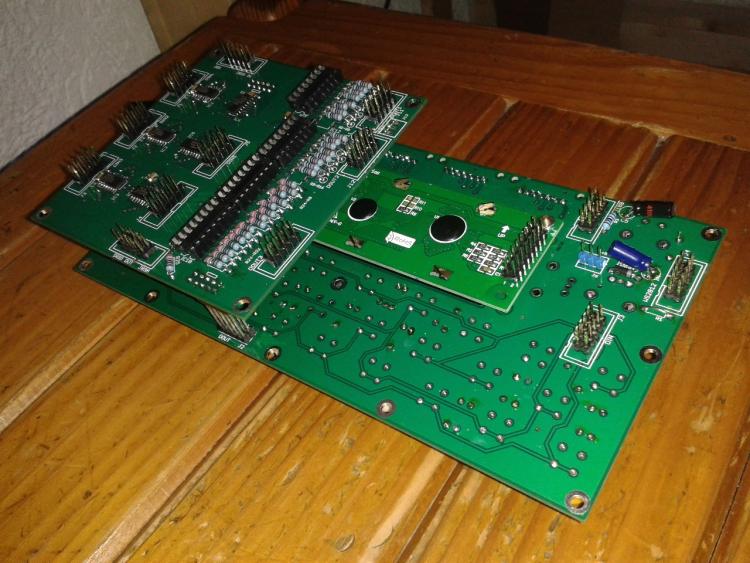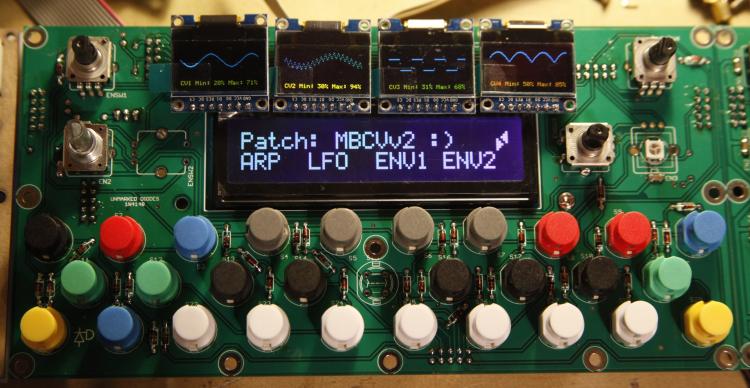-
Posts
2,516 -
Joined
-
Last visited
-
Days Won
147
Content Type
Profiles
Forums
Blogs
Gallery
Posts posted by latigid on
-
-
To reiterate; when using Windows each time the Core resets you need to restart MIOS Studio to properly "sync" the USB-MIDI connection. It's annoying, especially because you have to click through an additional dialogue window asking if changes to the computer are permissible.
-
Can you get back to the bootloader by pressing (and holding) the blue button?
http://www.ucapps.de/mios32_bootstrap_newbies.html
Bootloader mode is enforced as long as the blue button is down.
I got confused about this a little while ago; you can then upload the bootloader hex file, thereafter you don't need to hold the button any more.
Now you have a stable USB-MIDI connection and you can upload your application of choice. I'm not sure if re-uploading the bootloader hex is actually needed...? but it can't hurt.
-
Just had to fiddle with this the other day :). Install the bootloader hex, that's where you store LCD settings. Note: if you've already bootstrapped your Core the normal MIDI-USB works fine. On Windows you have to restart MIOS Studio every time the F4 board resets.
And don't forget to "store" the settings when done.
-
Just now, Zam said:
I have a doubt, maybe it's 2.048V typical...
2.048 is correct.
After the op amps you should get to 10.67V max. Check also your power supply to these. Maybe post a photo of your setup/soldering too.
-
Are you using the bipolar mode? There's a known issue with equal divider resistors.
-
Just now, TK. said:
So, instead of transposing semitones, you would like to transpose the whole notes, and they should be displayed as 1/<octave>..7/<octave> - correct?
As a suggestion, we could instead use the "Roman" notation as discussed earlier in the week.
Naturally this would have to take the current scale into account; is this too limiting for "non-Western" scales?
-
I was pretending to be Suisse for a while, but I just torture Nico with my attempted French :).
-
-
That the test app was loaded is a big clue that not everything was well (tashikoma). So now your task is to check the hardware connections, make sure all boards and shift registers are working, then get the correct firmware loaded. Without any photos of the unit running it's difficult to say how far the original builder got. But if you dive into the firmware files you might find the switches etc. can be customised/tweaked to the hardware you have. Best of luck!
-
Sorry, I see that you wrote "as-is" in the OP.
For the IC, it's probably the same LED driver for the second 7-segment. I guess the decimal point is not wired. The main functions should work fine without this connected.
-
http://www.ucapps.de/mios_download.html is where you'll find the firmware.
-
Have you asked the seller about it? Was it sold as working or as-is/for parts? You should connect it to MIOS Studio via MIDI to see if you can communicate with the Core, thereafter you can try to upload the correct application.
-
-
-
There's no stupidity, one has to scratch a little bit at a time with such a complex instrument.
With regards to chords and scales, an A minor chord always has the same notes played (A, C, E), but whether A is played as a major or minor chord depends on the scale "quality" and root note.
Major scale:
I ii iii IV V vi vii°so in C we have C Dm Em F G Am B° and back to C
minor scale:
i ii° III iv V VI VII vii°https://en.wikipedia.org/wiki/Roman_numeral_analysis
So the uppercase roman numerals are major chords, the lowercase are minors, and it's all subjective because C uses the same notes as Am. The little circles represent diminished chords, where the interval from the root note is a lowered
thirdfifth.If you use one of the many scale flavours in the SEQ, these will be different again.
-
If it all works with other displays/cables, then it's the display. TK could probably tell what pin is buggered from the output, but not a mere mortal such as myself. Sadly it's quite easy to cook the onboard registers, even as much as shorting pins together with a multimeter probe, experiments with 5V/3v3 fiddling, backwards cable etc.
-
Check the orientation/soldering of your resistor network/595. Can't see your pic btw.
-
Hello!
I don't pretend to know everything about the SEQ, I'm only starting to learn it myself and there's a lot to learn! But I think most of the requests/ideas you have are already possible within the current software. If they aren't yet TK. is the guy to tell you if they can be.
11 hours ago, derkollo said:- increase/decrease in the echo intervall per step. So you can have effects that sounds like a ping pong ball on a table. (I hope you know what i mean)
- option to say that the increase/decrease only occurs every nth step.
- the possibility to change the notevalue in the same way: Increase/Decrease notevalue+n every nth repeat.
So you can have one step/note played as "bam bam bam - bim bim bim - bom bom bom". If you know what i mean xD)Have you experimented with the LFOs? One can also assign meta tracks to modulate parameters in time with the sequence
11 hours ago, derkollo said:But here comes the real part i want to see the Seq be able someday. I will try to help as much as i can to make it possible! ;)
The first "easy" part (sry if the seq allready can do that, i only have it since a few days.....much to read/learn):
The possibilty to "record" notevalues over a Slider while playing: You enter the possitions where notes should be played and you "control" the melody over a Slider.
If your slider can generate CC data, I don't see why this couldn't be recorded/overdubbed. I haven't gone too deep with the BLM, but you can assign slider data to SEQ parameters (or have it sent out a MIDI port).
11 hours ago, derkollo said:I also implented musical scales. And a "notefilter" that only allows notes to be used that are in the chosen scale!
Force to scale is already present, but what's missing is the gate to tell the SEQ when to play a note.
11 hours ago, derkollo said:Play: This track is completly in CMajor.
Or the first bar is CMajor and bars 2-4 are in Dminor.
If you did that and programmed a nice melody you can transpose the whole pattern into every scale you want!
And that via keyboard in realtime!Transpose is implemented and can follow an external keyboard.
11 hours ago, derkollo said:What does that mean?
You program a track with 4 bars and a nice melodic motive in F#Minor. You mark the track as F#Minor. Now you just loop this
and transpose the melody while playing with just one key on the keyboard. For example you have all minor scales in the 2. Octave, all the major in the 1. etc...
When you now press D2 your track is transposed into Dminor. If you press A1 it will be played in Amajor, etc....I'm not following exactly, because you're talking about changing the root note and "quality" (i.e. major/minor) of a scale? Does this make musical sense?
11 hours ago, derkollo said:Oh and another feature:
When you start with the feature as above you will quickly come to tracks that are "perfect" but not in time. So... i added the possibility to "move tracks" steps to the right/left.Pretty sure you can nudge tracks.
Try to sit down and explore the SEQ a bit. The draft manual here is very useful and can give a lot of hints to get the best out of your instrument.
Happy sequencing!
-
Illuminated encoders in full RGB:
Now I need those "Waldorf" clear knobs!
-
 2
2
-
-
Pretty rainbows!
-
Works well! (at least the LED part). Encoders are up next.
-
 1
1
-
-
?
As far as I know, there haven't been banksticks in use since 2008. You might be confused with Patterns though. You get 64 patterns per Group, so each of Tracks 1-4, 5-8, 9-12 and 13-16 have 64 patterns storable.
-
Just now, Elektruck said:
Yes, I also have a feature request!!!
In history I builded a P3 sequencer, from Collin from sequentix, and this had a special 'tune' knob. It was a really handy knob witch I used a lot with my old analoge synths. When you hit it it sends a C3 note-on midi command on all outputs, and when you hit it again it sends the corresponding note-off command, I would love such a button cause it eliminates a technical setup step, really easy tuning!
Cheers,
Roel
Couldn't you just save a "tuning" track, and then load/play when you want to tune up?
-
Should be mentioned that the ribbon connection is made on the underside of the SEQ PCB. Also that you don't HAVE to use a box header, regular 100mil pin headers are just fine. When looking at the IDC connector from a bird's eye view, the notch goes at the bottom and pin 1 is the lower left. Just match the left sides together as Shuriken says and you're golden.
(BTW it's SI and SO, for serial input and output. SO from the Core drives the DOUT chain, while SI to the Core carries the DIN data stream.)






midibox SID rack 1U project [completed]
in MIDIbox SID
Posted
Cool boards! For the Core+SID, maybe check a few clearances:
I would put the voltage regulators at the edge of the board, this way they're easier to heatsink if needed and they radiate heat away from the SIDs/capacitors etc.
Is there a reason for two bridge rectifiers?
Have you thought about the grounding scheme around the SIDs? I know the MB-6582 board has a gap in the ground plane, presumably to keep the digital noise off the audio circuits.
You can check the sammichSID layout for inspiration, although it's a little bigger than your 10*10cm.